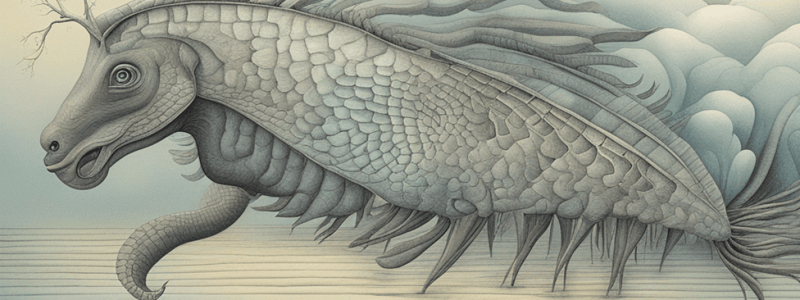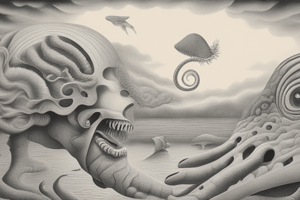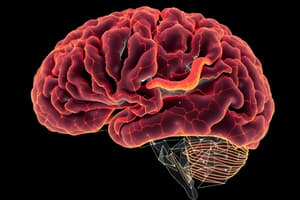Podcast
Questions and Answers
In (Rowland et al., 2011), What happened to the majority of inner box place fields in the CPP-injected animals?
In (Rowland et al., 2011), What happened to the majority of inner box place fields in the CPP-injected animals?
- They remained stable, except for those that had previously remapped due to wall removal (correct)
- They showed no change in response to the CPP
- They all remapped again in response to the CPP
- They remapped again, except for those that had previously remapped due to wall removal
In (Rowland et al., 2011), What was the behavior of outer box place fields in the CPP animals compared to the saline animals and inner box place fields of the CPP group?
In (Rowland et al., 2011), What was the behavior of outer box place fields in the CPP animals compared to the saline animals and inner box place fields of the CPP group?
- Outer box place fields in the CPP animals showed no change, unlike the saline animals and inner box place fields of the CPP group
- Outer box place fields in the CPP animals remained stable, similar to the saline animals and inner box place fields of the CPP group
- Outer box place fields in the CPP animals disappeared, unlike the saline animals and inner box place fields of the CPP group
- Outer box place fields in the CPP animals remapped again, unlike the saline animals and inner box place fields of the CPP group (correct)
In (Rowland et al., 2011), What do the data from Figure 4 strongly suggest about the establishment of place fields representing the newly explored outer box?
In (Rowland et al., 2011), What do the data from Figure 4 strongly suggest about the establishment of place fields representing the newly explored outer box?
- They were established only when the animal directly experienced it in session O2
- They were established only when the animal directly experienced it in session O1 (correct)
- They were established randomly throughout different sessions
- They were established through extensive observation of a space
In (Rowland et al., 2011), What happened to the firing rate of fast-spiking putative interneurons (theta cells) as the animal explored the outer box for the first time?
In (Rowland et al., 2011), What happened to the firing rate of fast-spiking putative interneurons (theta cells) as the animal explored the outer box for the first time?
In (Rowland et al., 2011), What is the primary focus of the paper?
In (Rowland et al., 2011), What is the primary focus of the paper?
In (Rowland et al., 2011), What did the experiments in the paper reveal about the stability of place fields in observed areas?
In (Rowland et al., 2011), What did the experiments in the paper reveal about the stability of place fields in observed areas?
In (Rowland et al., 2011), What was the purpose of using pharmacological blockade of NMDA receptor-dependent plasticity in the experiments?
In (Rowland et al., 2011), What was the purpose of using pharmacological blockade of NMDA receptor-dependent plasticity in the experiments?
In (Rowland et al., 2011), What did the study suggest about the formation of place fields in relation to active exploration?
In (Rowland et al., 2011), What did the study suggest about the formation of place fields in relation to active exploration?
In (Rowland et al., 2011), What key finding emerged regarding the stability of hippocampal representations from observation alone?
In (Rowland et al., 2011), What key finding emerged regarding the stability of hippocampal representations from observation alone?
In (Rowland et al., 2011), What insight did the paper provide about the role of NMDA receptor-dependent plasticity in forming stable place fields?
In (Rowland et al., 2011), What insight did the paper provide about the role of NMDA receptor-dependent plasticity in forming stable place fields?
In (Rowland et al., 2011), What was the purpose of using a customized environment and pharmacological blockade of NMDA receptor-dependent plasticity in the experiments?
In (Rowland et al., 2011), What was the purpose of using a customized environment and pharmacological blockade of NMDA receptor-dependent plasticity in the experiments?
In (Rowland et al., 2011), What was the implication of the study's results regarding the formation of stable place fields?
In (Rowland et al., 2011), What was the implication of the study's results regarding the formation of stable place fields?
In (Rowland et al., 2011), What was the significance of the injection of the NMDA receptor antagonist CPP or saline in the experiments?
In (Rowland et al., 2011), What was the significance of the injection of the NMDA receptor antagonist CPP or saline in the experiments?
In (Rowland et al., 2011), What was the finding regarding the removal of an inner wall in the experiments?
In (Rowland et al., 2011), What was the finding regarding the removal of an inner wall in the experiments?
In (Rowland et al., 2011), What was the implication of rotating the outer box 90 degrees after finding place cells?
In (Rowland et al., 2011), What was the implication of rotating the outer box 90 degrees after finding place cells?
In (Rowland et al., 2011), What was the aim of using CPP in evaluating place field stability?
In (Rowland et al., 2011), What was the aim of using CPP in evaluating place field stability?
In (Kentros et al., 2004), What is the focus of the study?
In (Kentros et al., 2004), What is the focus of the study?
In (Kentros et al., 2004), What did the novel environment group, exposed to a novel environment between familiar environment sessions, experience in terms of place field stability?
In (Kentros et al., 2004), What did the novel environment group, exposed to a novel environment between familiar environment sessions, experience in terms of place field stability?
In (Kentros et al., 2004), What role does attention play in the storage and retrieval of spatial memory, according to the study?
In (Kentros et al., 2004), What role does attention play in the storage and retrieval of spatial memory, according to the study?
In (Kentros et al., 2004), What is implicated in the attentional process as per the study's findings?
In (Kentros et al., 2004), What is implicated in the attentional process as per the study's findings?
In (Kentros et al., 2004), What did the spatial task group, recorded while successfully executing an operant place preference task, exhibit in terms of place field stability?
In (Kentros et al., 2004), What did the spatial task group, recorded while successfully executing an operant place preference task, exhibit in terms of place field stability?
In (Kentros et al., 2004), According to the study, what influences the stability of a hippocampal place cell representation of an environment?
In (Kentros et al., 2004), According to the study, what influences the stability of a hippocampal place cell representation of an environment?
In (Kentros et al., 2004), What was the purpose of using four different behavioral groups in the study?
In (Kentros et al., 2004), What was the purpose of using four different behavioral groups in the study?
In (Kentros et al., 2004), What did the study reveal about the stability of place fields in the 'no task' behavioral group?
In (Kentros et al., 2004), What did the study reveal about the stability of place fields in the 'no task' behavioral group?
In (Kentros et al., 2004), What implication emerged regarding the stability of place fields in the spatial task group?
In (Kentros et al., 2004), What implication emerged regarding the stability of place fields in the spatial task group?
In (Kentros et al., 2004), What did the findings suggest about the dependency of long-term place field stability?
In (Kentros et al., 2004), What did the findings suggest about the dependency of long-term place field stability?
What key role did attention play in the study by Clifford G. Kentros et al. (2004)?
What key role did attention play in the study by Clifford G. Kentros et al. (2004)?
In (Kentros et al., 2004), What is the main factor determining the stability of hippocampal place cell representations?
In (Kentros et al., 2004), What is the main factor determining the stability of hippocampal place cell representations?
In (Kentros et al., 2004), What were the results of the study regarding the effect of group on field size and information content?
In (Kentros et al., 2004), What were the results of the study regarding the effect of group on field size and information content?
In (Kentros et al., 2004), What did the study suggest about the response to reinforcing stimuli in spatial task animals?
In (Kentros et al., 2004), What did the study suggest about the response to reinforcing stimuli in spatial task animals?
In (Kentros et al., 2004), What was proposed as providing neuromodulatory inputs that switch short-term synaptic plasticity to long-term plasticity?
In (Kentros et al., 2004), What was proposed as providing neuromodulatory inputs that switch short-term synaptic plasticity to long-term plasticity?
In (Kentros et al., 2004), What did the study suggest about the effect of rotating the goal and cues in opposition to each other on animals performing the spatial task?
In (Kentros et al., 2004), What did the study suggest about the effect of rotating the goal and cues in opposition to each other on animals performing the spatial task?
In (Kentros et al., 2004), What was observed regarding the investigation of novel cues after training in the spatial task?
In (Kentros et al., 2004), What was observed regarding the investigation of novel cues after training in the spatial task?
In (Kentros et al., 2004), What does the study suggest about selective attention and maximal place field stability?
In (Kentros et al., 2004), What does the study suggest about selective attention and maximal place field stability?
Flashcards are hidden until you start studying
Study Notes
Rowland et al. (2011)
- Majority of inner box place fields disappeared in CPP-injected animals.
- Outer box place fields in CPP animals were similar to those in saline animals, but different from inner box place fields in the CPP group.
- Data suggest that place fields representing the newly explored outer box were established through active exploration.
- Firing rate of fast-spiking putative interneurons (theta cells) decreased as the animal explored the outer box for the first time.
- Primary focus of the paper is on the formation and stability of place fields.
- Experiments revealed that place fields in observed areas are unstable without active exploration.
- Pharmacological blockade of NMDA receptor-dependent plasticity was used to study the role of NMDA receptors in forming stable place fields.
- Study suggests that active exploration is necessary for the formation of place fields.
- Key finding: Stability of hippocampal representations is dependent on active exploration, not just observation.
- NMDA receptor-dependent plasticity is necessary for forming stable place fields.
Kentros et al. (2004)
- Focus of the study is on the role of attention in the storage and retrieval of spatial memory.
- Novel environment group exhibited unstable place fields, while the spatial task group exhibited stable place fields.
- Attention plays a key role in the storage and retrieval of spatial memory.
- Dopamine is implicated in the attentional process.
- Spatial task group exhibited stable place fields, while the 'no task' group did not.
- Study reveals that attention influences the stability of hippocampal place cell representations of an environment.
- Purpose of using four different behavioral groups was to study the effect of attention on place field stability.
- Study suggests that attention is necessary for long-term place field stability.
- Attention plays a key role in the formation and stability of place fields.
Studying That Suits You
Use AI to generate personalized quizzes and flashcards to suit your learning preferences.




